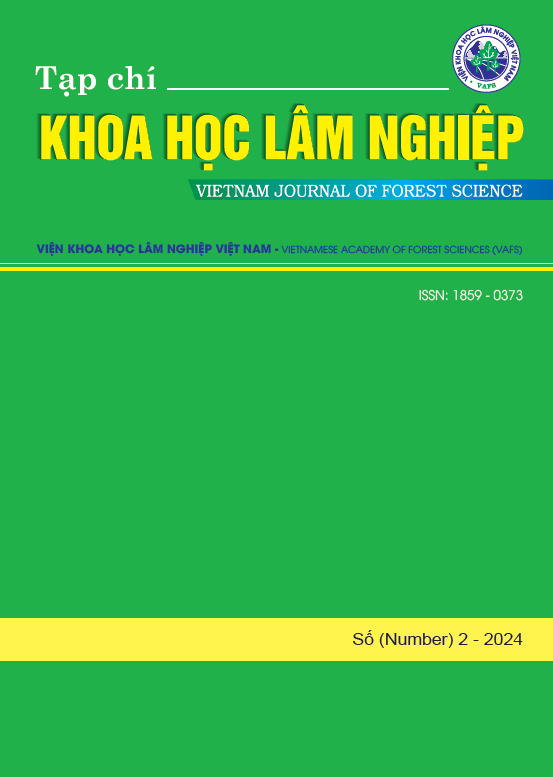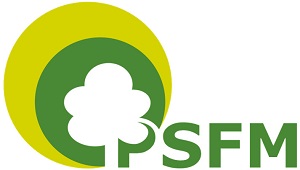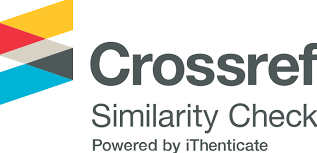ĐÁNH GIÁ HIỆU SUẤT CỦA ẢNH VỆ TINH SENTINEL 2A VÀ PLANETSCOPE TRONG PHÂN LOẠI THẢM PHỦ RỪNG TẠI VƯỜN QUỐC GIA TÀ ĐÙNG, ĐẮK NÔNG, VIỆT NAM
Từ khóa:
SE-2A, PlanetScope, SVM, phân loại thảm phủ rừng, độ chính xác phân loại, GIS, viễn thámTóm tắt
Trong nghiên cứu này, đã tiến hành phân tích và so sánh hiệu quả của hai loại ảnh vệ tinh, Sentinel 2A (SE-2A) và PlanetScope trong việc phân loại thảm phủ rừng tại Vườn Quốc gia Tà Đùng, Việt Nam dựa trên các mức độ tác động. Mục tiêu chính là để đánh giá độ chính xác và hiệu quả của hai loại ảnh này trong việc cung cấp dữ liệu về hiện trạng và sự phân bố của các thảm phủ rừng, hỗ trợ công tác quản lý bảo tồn tài nguyên rừng. Thuật toán SVM (Support Vector Machine) được sử dụng để phân loại cho cả hai nguồn ảnh vệ tinh. Kết quả cho thấy có sự chênh lệch về độ chính xác phân loại và ước lượng diện tích các loại thảm phủ rừng giữa hai nguồn dữ liệu. Tuy vậy, cả hai loại ảnh đều cho kết quả phân loại thảm phủ rừng có độ tin cậy cao, với tỷ lệ chính xác trên 90% cho rừng và các loại đất khác và trên 80% cho từng loại thảm phủ rừng (rừng bị tác động ít, rừng tác động trung bình và rừng tác động mạnh). Kết quả nghiên cứu chỉ ra, mặc dù có độ phân giải thấp hơn nhưng ảnh SE-2A vẫn có độ chính xác đáng tin cậy là 84,5% so với ảnh PlanetScope là 87,94%. PlanetScope có độ tin cậy cao nhưng phải tốn chi phí và số lượng band ảnh hạn chế với 4 band ảnh. Trong khi đó, SE-2A có số lượng band ảnh lớn hơn với 13 band ảnh, đồng thời dữ liệu được cung cấp miễn phí và cập nhật định kỳ. Do đó, việc lựa chọn nguồn dữ liệu vệ tinh cho nghiên cứu cần cân nhắc dựa trên nguồn ngân sách, mục tiêu nghiên cứu và đánh giá ưu nhược điểm của mỗi nguồn để đưa ra quyết định phù hợp.
Tài liệu tham khảo
Amy E. Frazier and Benjamin L. Hemingway, 2021. “A Technical Review of Planet Smallsat Data: Practical Considerations for Processing and Using PlanetScope Imagery” Remote Sensing, 13(19), 3930.
Asnake Yimam Yesuph and Amare Bantider Dagnew, 2019. “Land use/cover spatiotemporal dynamics, driving forces and implications at the Beshillo catchment of the Blue Nile Basin, North Eastern Highlands of Ethiopia”, Environmental Systems Research Volume 8, Article number: 21.
Burges, C. J. C., 1998. “A Tutorial on Support Vector Machines for Pattern Recognition”. Data Mining and Knowledge Discovery, 2(2), 121-167.
Congalton, R. G., 1991. A review of assessing the accuracy of classifications of remotely sensed data. Remote Sensing of Environment, 37(1), 35-46.
Congalton, R. G., & Green, K., 2019. Assessing the Accuracy of Remotely Sensed Data: Principles and Practices (3rd ed.). CRC Press.
Conchedda, G., 2008. “An Improved Method for the Assessment of Map Accuracy in Ecological Land Cover Studies”. Environmental Management, vol. 42, no. 4, pp. 709-718.
Cristianini, N., & Shawe-Taylor, J., 2000. “An Introduction to Support Vector Machines and Other Kernel-based Learning Methods”, Cambridge University Press, https://doi.org/10.1017/CBO9780511801389
Charlotte Pelletier, 2016. “Assessing the robustness of Random Forests to map land cover with high resolution satellite image time series over large areas”, Remote Sensing of Environment, 187(1), p. 156-168.
Drusch, M., Del Bello, U., Carlier, S., Colin, O., Fernandez, V., Gascon, F. & Meygret, A., 2012. Sentinel-2: ESA's Optical High-Resolution Mission for GMES Operational Services. Remote Sensing of Environment, 120, 25-36.
Foody, G. M., & Mathur, A., 2004. “A relative evaluation of multiclass image classification by support vector machines”. IEEE Transactions on Geoscience and Remote Sensing, 42(6), 1335-1343.
Foody, G. M., 2002. “Status of land cover classification accuracy assessment”. Remote Sensing of Environment, 80(1), 185-201.
Anju Asokan, J. Anitha, Monica Ciobanu, Andrei Gabor, Antoanela Naaji and D. Jude Hemanth, 2020. Image Processing Techniques for Analysis of Satellite Images for Historical Maps Classification. MPDI, Appl. Sci. 2020. 10(12), 4207; https://doi.org/10.3390/app10124207.
Ferran Gascon, Catherine Bouzinac, Olivier Thépaut, Mathieu Jung, Benjamin Francesconi, Jérôme Louis, Vincent Lonjou, Bruno Lafrance, Stéphane Massera, Angélique Gaudel-Vacaresse, Florie Languille, Bahjat Alhammoud, Françoise Viallefont, Bringfried Pflug, Jakub Bieniarz, Sébastien Clerc, Laëtitia Pessiot, Thierry Trémas, Enrico Cadau, Roberto De Bonis, Claudia Isola, Philippe Martimort and Valérie Fernandez, 2017. “Copernicus Sentinel-2A Calibration and Products Validation Status”. Remote Sensing, 9(6), 584.
Gorelick, N., Hancher, M., Dixon, M., Ilyushchenko, S., Thau, D., & Moore, R., 2017. Google Earth Engine: Planetary-scale geospatial analysis for everyone. Remote Sensing of Environment, 202, 18-27.
Chih-Wei Hsu, Chih-Chung Chang, and Chih-Jen Lin, 2003. “A Practical Guide to Support Vector Classification”, Last updated: April 15, 2010, National Taiwan University, Taipei 106, Taiwan.
Huang, C., Davis, L. S., & Townshend, J. R. G., 2002. “An assessment of support vector machines for land cover classification”. International Journal of Remote Sensing, 23(4), 725-749.
Jensen, J. R., 2015. “Introductory Digital Image Processing: A Remote Sensing Perspective”. Pearson Education.
Johnson, D. E., & Lee, Y. O., 2022. Contrast Adjustment Techniques in Satellite Imagery. Satellite Imaging Technology Review, 12(2), 145-158.
Johnson, K. L., Gupta, A., & Kumar, M., 2022. Evaluating the Performance of SVM Classifiers in Remote Sensing Imagery Analysis. Journal of Geographical Information Systems. http://dx.doi.org/10.1117/12.2532577
Kim J., Park, S., & Lee, H., 2023. The Impact of Image Preprocessing on Deep Learning Models: A Comprehensive Study. International Journal of Advanced Computer Science and Applications.
Lee, C. S., & Yeh, H. T., 2018. “Enhancing Vegetation Index Accuracy Using Multispectral Satellite Data.” Remote Sensing Review, vol. 36, no. 4, pp. 456-469.
Lillesand, T., Kiefer, R. W., & Chipman, J., 2015. Remote Sensing and Image Interpretation (7th ed.). Wiley.
Lowe B. and Kulkarni A., 2015. “Multispectral Image Analysis Using Random Forest”. International Journal on Soft Computing (IJSC) Vol.6 (No. 1), February 2015.
Mountrakis, G., Im, J., & Ogole, C., 2011. Support vector machines in remote sensing: A review. ISPRS Journal of Photogrammetry and Remote Sensing, 66(3), 247-259.
Muster, S., 2020. “Evaluating the Accuracy of Satellite Remote Sensing in Land Classification: A Comparative Study of Sentinel 2A and PlanetScope.” Journal of Remote Sensing, 34(3), 1123-1138.
Moritz Rösch, Ruth Sonnenschein, Sebastian Buchelt and Tobias Ullmann, 2022. Comparing PlanetScope and Sentinel-2 Imagery for Mapping Mountain Pines in the Sarntal Alps, Italy. Journal of Remote Sensing, 14(13), 3190; https://doi.org/10.3390/rs14133190.
Mohammed J Yousif, 2024. Enhancing The Accuracy of Image Classification Using Deep Learning and Preprocessing Methods, https://doi.org/10.52098/airdj.2023348.
Nguyễn Thị Thanh Hương, 2022. “Phương pháp ứng dụng viễn thám và GIS trong lâm nghiệp”, Nhà xuất bản Đại học Huế.
Nguyễn Thị Thanh Hương, Châu Thị Như Quỳnh, Nguyễn Đức Định, Phan Thị Hằng, Cao Thị Hoài, Nguyễn Thế Hiển, Đặng Ngọc Trí, Ngô Thế Sơn, Đoàn Minh Trung, Hồ Đình Bảo, Ngô Thị Thùy Phương, Nguyễn Công Tài Anh, Võ Hùng và Hoàng Trọng Khánh, 2018. “Thử nghiệm định lượng đa dạng loài thực vật thân gỗ tại tỉnh Đắk Nông dựa vào ảnh vệ tinh”, Tạp chí Khoa học, chuyên đề khoa học và công nghệ, Trường Đại học Sư phạm Thành phố Hồ Chí Minh, 15(11b), tr 54 - 62.
Nguyễn Thị Thanh Hương, Nguyễn Đức Định, Châu Thị Như Quỳnh, Nguyễn Thế Hiển, Phan Thị Hằng, Cao Thị Hoài, Hồ Đình Bảo, 2019. “Đa dạng loài thực thân gỗ của kiểu rừng lá rộng thường xanh tại Vườn Quốc gia Tà Đùng, tỉnh Đắk Nông”, Đại học Tây Nguyên
Huong Thi Thanh Nguyen, Trung Minh Doan, Erkki Tomppo and Ronald E. McRoberts, 2020. “Land Use/Land Cover Mapping Using Multitemporal Sentinel-2 Imagery and Four Classification Methods-A Case Study from Dak Nong, Vietnam”, Remote Sens. 12(9), 1367; https://doi.org/10.3390/rs12091367
Planet., 2020. “PlanetScope: High-Resolution Imaging with Rapid Revisit Rates”. Retrieved from Planet's official website.
Paula Rivas‑Fandiño, Carolina Acuña‑Alonso, Ana Novo, Fernando António Leal Pacheco, Xana Álvarez, 2023. “Assessment of high spatial resolution satellite imagery for monitoring riparian vegetation”, Environ Monit Assess Volume 195, article number 81, https://doi.org/10.1007/s10661-022-10667-8
Richards, J. A., & Jia, X., 2006. Remote Sensing Digital Image Analysis: An Introduction (4th ed.). Springer.
Roy, D. P., Wulder, M. A., Loveland, T. R., Woodcock, C. E., Allen, R. G., Anderson, M. C., Helder, D., Irons, J. R., Johnson, D. M., Kennedy, R., Scambos, T. A., Schaaf, C. B., Schott, J. R., Sheng, Y., Vermote, E. F., Belward, A. S., Bindschadler, R., Cohen, W. B., Gao, F., Hipple, J. D., Hostert, P., Huntington, J., Justice, C. O., Kilic, A., Kovalskyy, V., Lee, Z. P., Lymburner, L., Masek, J. G., McCorkel, J., Shuai, Y., Trezza, R., Vogelmann, J., Wynne, R. H., & Zhu, Z., 2014. Landsat-8: Science and product vision for terrestrial global change research. Remote Sensing of Environment, 145, 154-172.
Schölkopf, B., & Smola, A. J., 2002. “Learning with Kernels: Support Vector Machines, Regularization, Optimization, and Beyond”. MIT Press.
Smith, J. A., Nguyen, H. T., & Patel, S. K., 2021. Advanced Techniques in Satellite Image Processing. Journal of Remote Sensing Applications, 35(4), 256-274. https://doi.org/10.1234/jrsa.2021.112233
Tesfaye Adugna, Wenbo Xu and Jinlong Fan, 2022. Comparison of Random Forest and Support Vector Machine Classifiers for Regional Land Cover Mapping Using Coarse Resolution FY-3C Images. Remote Sens. 2022, 14(3), 574; https://doi.org/10.3390/rs14030574
Stehman, S. V., 1997. “Selecting and Interpreting Measures of Thematic Classification Accuracy.” Remote Sensing of Environment, vol. 62, no. 1, pp. 77-89.
Sonam Wangyel Wang, Belay Manjur Gebru, Munkhnasan Lamchin, Rijan Bhakta Kayastha and Woo-Kyun Lee, 2020. “Land Use and Land Cover Change Detection and Prediction in the Kathmandu District of Nepal Using Remote Sensing and GIS.”, MPDI, Sustainability 2020, 12(9), 3925; https://doi.org/10.3390/su12093925
Tucker, C. J., 1979. Red and photographic infrared linear combinations for monitoring vegetation. Remote Sensing of Environment, 8(2), 127-150.
Vapnik, V., 1995. The Nature of Statistical Learning Theory. Springer-Verlag.
Wulder, M. A., Loveland, T. R., Roy, D. P., Crawford, C. J., Masek, J. G., Woodcock, C. E., & Herold, M, 2019. “Current Status of Landsat Program Science and Applications”. Remote Sensing of Environment, 225, 127-147.













